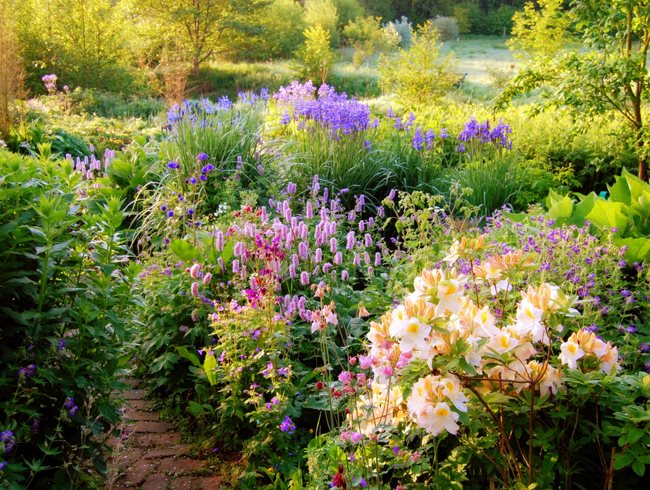Image Credit: Garden Design
By Lauren Pelayo
Are you a born garden enthusiast but lack the green thumb to support your growing goals? Do you love the look and feel of a lush backyard but lack the time for extensive yard maintenance? Not to worry, here’s a list of 10 low maintenance plants that even the most amateur gardeners will have a hard time to kill.
Hostas

Image Credit: Swallow Tail Gardens
Hostas are one of those perennials that come in a variety of species and require little to no attention even if your garden is one that doesn’t get a whole lot of sunlight. Some species of hostas also bloom flowers and attract bees as well as butterflies. These plants grow well in zones 3-9, and will require “cut back” in the fall to ensure spring blooms. Hostas make for lovely border plants, and will fill your heart with happiness year after year.
Siberian Iris

Image Credit: Grimms Gardens
If you’re looking to bring bold energy and style to your garden then Siberian Iris’ are a great choice. These low maintenance flowers love the sun and thrive in rich well drained soil. One stem can bring three flowers giving them a full look. Once the flowers have faded the stems keep their green appearance allowing your garden to keep its lush energy. Siberian Irises thrive in zones 3-8 and enjoy moist but not soggy soil. Depending on your color scheme these bold flowers come in yellows, purples and blues; giving you a good variety to choose from.
Peonies

Peonies are a truly decadent flower bushes and require little to no effort at all. Once established they’ll grow back year after year. Typically Peonies are some of the first to grow after the last frost (in most climates that see all seasons), and will bloom mid may. It’s best to grow these bushes on the outskirts of your garden, farthest from your home since they do attract ants. Peony bushes vary in color and should be pruned once all the blooms have tilted back to the earth. They’re considered drought tolerant but do thrive in rainy climates. These bushes love basking in full sun for most of the day and enjoy partial shade in the afternoon. They'r3e considered hardy to zone 3 & grow well as far south as zone’s 7 & 8. Year after year I look forward to my peony bushes because they mark the beginning of a new season and reward me with happy pink flowers with an aroma that’s like a sniff from the heavens.
Coneflower

Are you a Daisy lover but want an easy flower that brings a sassy edge? If your answer was yes, then consider planting echinacea or “coneflowers.” This happy flower comes in a variety of colors and can bring character to any garden. This hardy perennial is a fast grower and will stand upright as if reaching to the sky above. They’re known to attract bees and song birds such as gold finches; which are beneficial to gardens as they consume millions of insects that are damaging to crops and trees. Having echinacea in your garden brings a balance to surrounding ecosystems and once established will come back year after year. These hardy flowers thrive in zones 3-9 and love to bask in full sunlight.
Blue Mist Spirea

If you’re looking for an aromatic shrub with blue colors and brilliant late summer flowers then Blue Mist Spirea is an easy go to. This mounted shrub keeps its form throughout the year and can be a good fit if you have a smaller garden space. If your yard is prone to deer and rabbits this shrub will keep these animals away. Bringing this shrub to your garden will allow you to enjoy the energy of butterflies and bee’s as well as hummingbirds, and make good cut flowers for flower arrangements.
Giant Allium

Don’t be fooled by the photo because Giant Alliums are truly massive & quite show stopping. This herbaceous perennial is a minimal fuss bulb and grows quite tall between 40-60 inches. It comes from the onion family and is known to repel deer & rabbits. These bulbs are best planted at the end of the last frost and will bloom late spring to early summer. They thrive in full morning sun with afternoon shade and if cared for properly are considered “long-blooming,” making them excellent cut flowers. If you live in a rainy climate they will require little watering. Giant Alliums prefer well drained soil to prevent root rot and are known to attract beneficial insects like Bee’s and Butterflies.
Black Eyed Susan

If you’re looking to bring a cheerful energy to your garden black eyed susans are a must. These herbaceous annuals are incredibly drought tolerant and are known to reseed themselves. This happy bloomer makes an excellent cut flower and can stay in a vase for 8-10 days without wilting. These flowers do well in borders and even containers, and should be in a partial sunny environment rather than full sun. The plants can grow 3 feet tall, with leaves of 6 inches long and flowers with a diameter of 2-3 inches. They thrive in zones 3-9 and attract butterflies, making for happy healthy gardens.
Fountain Grass

If you’re someone who’s looking for easy ornamental grass then consider growing fountain grass. This clump-forming perennial is known for its fox-tail looking flowers and comes in a variety of colors such as tan, pink and purple. Due to the variety in species this plant is considered to be incredibly adaptable (best in hardy zones 4-10) no matter what climate you’re in. These plants prefer warm climates but can tolerate shady areas. They enjoy basking in full sun and enjoy fertile well-drained soil but can be considered drought tolerant. The fox-tail flowers typically bloom in late summer all the way to fall, giving your garden a full look till the shift in season for those who see all seasons. This plant can stand alone or in borders alongside other perennials. They also make excellent cut flowers that give a chic look in long vases for those Bohemian style looks.
Creeping Sedum

If you’re looking for a supportive plant that will help maintain the overall health of your garden then creeping sedum is a must, especially if you’re in a hotter climate. These enthusiastic succulents are incredibly low maintenance and are considered one of the best ground cover options. They are amazingly resilient and have been known to push through stones in the floor making them almost unstoppable. This low maintenance plant keeps the roots of neighboring plants cool, conserves moisture and will spread rapidly. Like most succulents they love the heat and will do well in well-drained soil thriving in hardy zones 4-9.
Ribbon Grass

If you’re looking to add texture and color to your garden then ribbon grass is an easy go to. Not only does it grow incredibly fast but it can be a good starter to those beginning projects. According to Dough Hetherington at Better homes & gardens “variegated ribbon grass thrives in almost all growing conditions. It is happy growing in anything from shallow standing water to dry, sandy clay.” This plant asks for very little and loves to bask in full sun but can tolerate afternoon shade once established. Be sure to plant this species in a place you would want them to remain permanently as they can be considered invasive and are known to spread vigorous rhizomes underground. To prevent its bully like behavior plant it in shaded areas that get plenty of moisture.
When it comes to successfully gardening it helps to have a plan. Taking the time to map out where certain plants will thrive will help you to successfully grow the garden of your dreams. Don’t be afraid to do a little bit of research and get to know your land so that planting will be an enjoyable journey; this will also help you to plant consciously and avoid garden bullies who can take over and strain surrounding plants. Every new garden planted helps our earth come back into harmony with natural cycles, so by starting your garden projects you’re making a lasting impact for generations to come.

